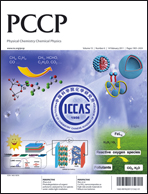The light-dependent reduction of protochlorophyllide, a key step in the synthesis of chlorophyll, is catalyzed by the enzyme protochlorophyllide oxidoreductase (POR) and requires two photons (O. A. Sytina et al., Nature, 2008, 456, 1001–1008). The first photon activates the enzyme–substrate complex, a subsequent second photon initiates the photochemistry by triggering the formation of a catalytic intermediate. These two events are characterized by different spectral changes in the infra-red spectral region. Here, we investigate the vibrational frequencies of the POR-bound and unbound substrate, and product, and thus provide a detailed assignment of the spectral changes in the 1800–1250 cm−1 region associated with the catalytic conversion of PChlide:NADPH:TyrOH into Chlide:NADP+:TyrO−. Fluorescence line narrowed spectra of the POR-bound Pchlide reveal a C![[double bond, length as m-dash]](https://www.rsc.org/images/entities/char_e001.gif) O keto group downshifted by more than 20 cm−1 to a relatively low vibrational frequency of 1653 cm−1, as compared to the unbound Pchlide, indicating that binding of the chromophore to the protein occurs via strong hydrogen bond(s). The frequencies of the C
O keto group downshifted by more than 20 cm−1 to a relatively low vibrational frequency of 1653 cm−1, as compared to the unbound Pchlide, indicating that binding of the chromophore to the protein occurs via strong hydrogen bond(s). The frequencies of the C![[double bond, length as m-dash]](https://www.rsc.org/images/entities/char_e001.gif) C vibrational modes are consistent with a six-coordinated state of the POR-bound Pchlide, suggesting that there are two coordination interactions between the central Mg atom of the chromophore and protein residues, and/or a water molecule. The frequencies of the C
C vibrational modes are consistent with a six-coordinated state of the POR-bound Pchlide, suggesting that there are two coordination interactions between the central Mg atom of the chromophore and protein residues, and/or a water molecule. The frequencies of the C![[double bond, length as m-dash]](https://www.rsc.org/images/entities/char_e001.gif) C vibrational modes of Chlide are consistent with a five-coordinated state, indicating a single interaction between the central Mg atom of the chromophore and a water molecule. Rapid-scan FTIR measurements on the Pchlide:POR:NADPH complex at 4 cm−1 spectral resolution reveal a new band in the 1670 cm−1 region. The FTIR spectra of the enzyme activation phase indicate involvement of a nucleotide-binding structural motif, and an increased exposure of the protein to solvent after activation.
C vibrational modes of Chlide are consistent with a five-coordinated state, indicating a single interaction between the central Mg atom of the chromophore and a water molecule. Rapid-scan FTIR measurements on the Pchlide:POR:NADPH complex at 4 cm−1 spectral resolution reveal a new band in the 1670 cm−1 region. The FTIR spectra of the enzyme activation phase indicate involvement of a nucleotide-binding structural motif, and an increased exposure of the protein to solvent after activation.
![[double bond, length as m-dash]](https://www.rsc.org/images/entities/char_e001.gif) O keto group downshifted by more than 20 cm−1 to a relatively low vibrational frequency of 1653 cm−1, as compared to the unbound Pchlide, indicating that binding of the
O keto group downshifted by more than 20 cm−1 to a relatively low vibrational frequency of 1653 cm−1, as compared to the unbound Pchlide, indicating that binding of the ![[double bond, length as m-dash]](https://www.rsc.org/images/entities/char_e001.gif) C vibrational modes are consistent with a six-coordinated state of the POR-bound Pchlide, suggesting that there are two coordination interactions between the central Mg atom of the
C vibrational modes are consistent with a six-coordinated state of the POR-bound Pchlide, suggesting that there are two coordination interactions between the central Mg atom of the ![[double bond, length as m-dash]](https://www.rsc.org/images/entities/char_e001.gif) C vibrational modes of Chlide are consistent with a five-coordinated state, indicating a single interaction between the central Mg atom of the
C vibrational modes of Chlide are consistent with a five-coordinated state, indicating a single interaction between the central Mg atom of the 

 Please wait while we load your content...
Please wait while we load your content...